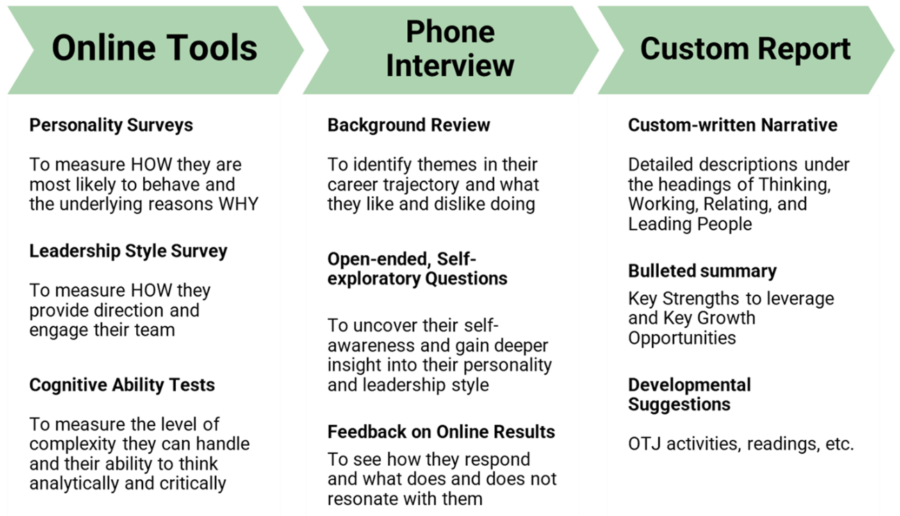Coaching for Leadership Development
We leverage science to accelerate the pace of change.
Our Coaching Philosophy
Our approach to coaching for leadership development is grounded in the science of personality and behavior change. Business psychologists conduct a comprehensive psychometric assessment at the start of every engagement. The assessment measures how the person is naturally wired. This helps the coach uncover the person’s strengths, motivations, and what may be holding them back. Our coaches use a combination of cognitive-behavioral, positive psychology (i.e., leveraging strengths), and solution-focused (i.e., constructing solutions to achieve specific outcomes) approaches.
Our Coaching Assessment Process at a Glance

To stay competitive, HR leaders must overcome these common roadblocks so they can gain buy-in for investing in leadership coaching.
Why Invest in Coaching for Leadership Development?
According to the International Coaching Federation, 86% of companies that measured the financial impact of leadership coaching experienced a Return on Investment. Some studies have shown over 700% ROI! Source Scholarly research also shows that a well designed coaching process leads to positive changes in leader effectiveness.
Because there is so much evidence of its positive business impact, the majority of organizations around the world are using leadership coaching. In fact, a recent study showed that 72% of organizations offer coaching for leadership development. Another 23% would like to offer leadership coaching. The most common reasons for not doing it are lack of budget and difficulty showing ROI. Source
We help remove barriers to leadership coaching with:
1. Budget-friendly Coaching Lite
The term “Coaching Lite” was popularized by Walmart’s coaching program back in the 1990s. The approach is intense at the start and followed up with shorter, less frequent check-ins. Research shows that for many outcomes, having < 5 coaching sessions produces the same or even better results than having 5 or more sessions. With cost and time committed being lower without sacrificing effectiveness, it’s no wonder that Coaching Lite is our most popular option.
2. Showing Return on Investment
A 2020 Global Coaching Study showed that evaluating the impact of coaching was the #1 ongoing challenge for most organizations. This is because there is no “one-size-fits-all” equation to measuring leadership coaching’s impact. So, Training Magazine suggests calculating Return on Expectations. The concept hinges on linking coaching to the relevant metrics and desired outcomes that matter for the organization. These should be tied to your organization’s mission, values, and goals.
For instance, one positive result of coaching is an improvement in employee engagement. So, if this is one of your strategic goals, engagement would be measured pre- and post-coaching. This can be done on a smaller scale (i.e., the leader and their direct reports complete a survey) or at the organizational level if a broader coaching program is in place.
Before any coaching for leadership development begins, we help you:
- Define your expected outcomes and how they tie to your mission, values, and goals.
- Determine what metrics you’ll use to evaluate those outcomes.
- Communicate a consistent message to the coach, client, and key internal stakeholders on the purpose of the coaching, the expected outcomes, and how those will be measure.
Factors Impacting Leadership Coaching Outcomes
Coaching Approach
Single approaches (e.g., cognitive behavioral, positive psychology, solution-focused, GROW) or Integrated approaches (e.g., cognitive behavioral and solution-focused) have been researched.
- An Integrated approach had a considerably larger effect on outcomes compared to a single approach methods.
- When vetting coaches, ask what approaches they use and listen for a blend of psychologically-informed approaches (e.g., Cognitive-behavioral and solution-focused).
Coaching Frequency
- The positive effect of coaching on Goal Attainment (i.e., reaching goals set at outset of coaching) and Self-efficacy (i.e., feeling capable and competent) outcomes can be achieved in less than 5 sessions with no significant increase with additional sessions.
- The positive effect of coaching on Skills/Performance and Work Attitudes increases considerably when 5 or more sessions are conducted. One hypothesis is that people who have more serious problems may have been contracted for more sessions. And, because of the severity of the issues, it took longer to turn around their performance or attitudes.
- Consider your desired outcomes for each coachee when determining how many sessions to include.
Coaching Modality
- The overall effect of coaching was similar for face-to-face and hybrid (face-to-face and phone) models. There were not enough studies with phone only or video-conference only to investigate.
- In-person, face-to-face coaching is not needed to achieve positive outcomes. When possible, give options to the coachee by allowing them to select which model is most comfortable for them.
Multi-Rater Feedback (MRF)
- When MRF was used as an input into coaching, the coaching was considerably less effective than when MRF was not an input into the process. The researchers hypothesized that the subjective nature of multi-rater feedback can evoke emotional responses and serve as a distraction that depletes cognitive resources needed to focus on the coaching process.
- Carefully consider how multi-rater feedback has been used in your organization, how well-received it has been, and whether the risks outweigh the payoff. If you decide to use it to help with the coaching engagement, consider administering it several months prior. Debrief the results with the leader before coaching begins.
